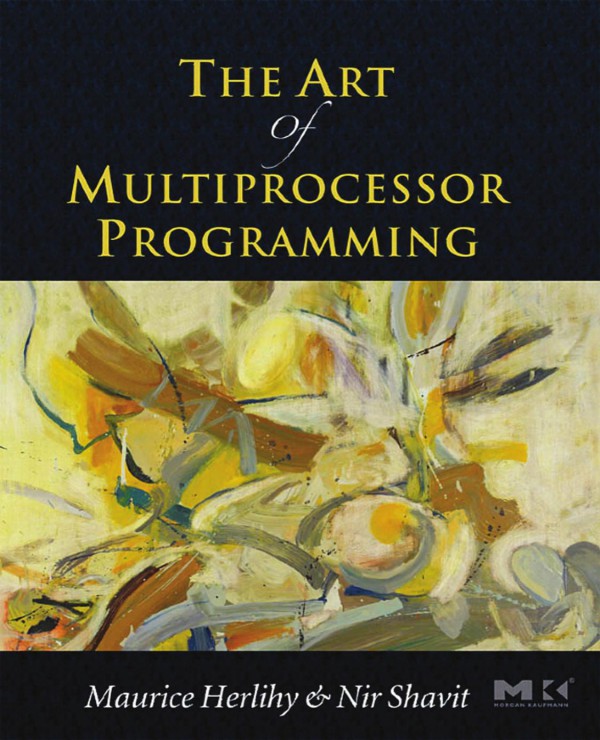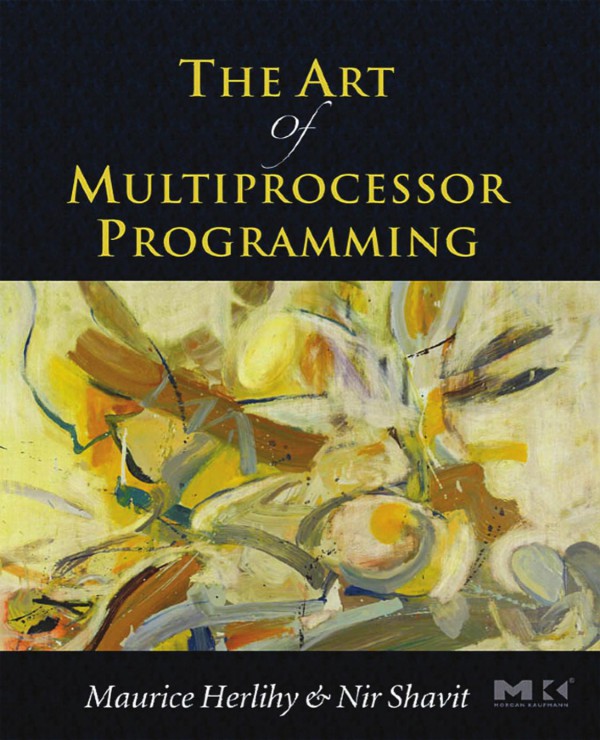Art of Multiprocessor Programming 1st edition by Maurice Herlihy, Nir Shavit 9780080569581 0080569587
$50.00 Original price was: $50.00.$25.00Current price is: $25.00.
Authors:Herlihy, Maurice.; Shavit, Nir , Author sort:Herlihy, Maurice.; Shavit, Nir , Languages:Languages:eng , Published:Published:Feb 2008
Art of Multiprocessor Programming 1st edition by Maurice Herlihy, Nir Shavit – Ebook PDF Instant Download/Delivery.9780080569581, 0080569587
Full download Art of Multiprocessor Programming 1st edition after payment

Product details:
ISBN 10: 0080569587
ISBN 13: 9780080569581
Author: Maurice Herlihy, Nir Shavit
As the computer industry changes from single-processor to multiprocessor architectures, this revolution requires a fundamental change in how programs are written. To leverage the performance and power of multiprocessor programming, also known as multicore programming, you need to learn the new principles, algorithms, and tools presented in this book. It includes fully-developed Java examples detailing data structures, synchronization techniques, transactional memory, and more.
Prof. Maurice Herlihy, who coined the phrase “transactional memory,” is on the faculty of Brown University. He is the recipient of the 2003 Dijkstra Prize in distributed computing. Prof. Nir Shavit is on the faculty of Tel-Aviv University and a member of the technical staff at Sun Microsystems Laboratories. In 2004 they shared the Gödel Prize, the highest award in theoretical computer science.
Art of Multiprocessor Programming 1st Table of contents:
Chapter 1. Introduction
1.1 Shared Objects and Synchronization
1.2 A Fable
1.3 The Producer–Consumer Problem
1.4 The Readers–Writers Problem
1.5 The Harsh Realities of Parallelization
1.6 Parallel Programming
1.7 Chapter Notes
1.8 Exercises
Part I: Principles
Chapter 2. Mutual Exclusion
2.1 Time
2.2 Critical Sections
2.3 2-Thread Solutions
2.4 The Filter Lock
2.5 Fairness
2.6 Lamport’s Bakery Algorithm
2.7 Bounded Timestamps
2.8 Lower Bounds on the Number of Locations
2.9 Chapter Notes
2.10 Exercises
Chapter 3. Concurrent Objects
3.1 Concurrency and Correctness
3.2 Sequential Objects
3.3 Quiescent Consistency
3.4 Sequential Consistency
3.5 Linearizability
3.6 Formal Definitions
3.7 Progress Conditions
3.8 The Java Memory Model
3.9 Remarks
3.10 Chapter Notes
3.11 Exercises
Chapter 4. Foundations of Shared Memory
4.1 The Space of Registers
4.2 Register Constructions
4.3 Atomic Snapshots
4.4 Chapter Notes
4.5 Exercises
Chapter 5. The Relative Power of Primitive Synchronization Operations
5.1 Consensus Numbers
5.2 Atomic Registers
5.3 Consensus Protocols
5.4 FIFO Queues
5.5 Multiple Assignment Objects
5.6 Read–Modify–Write Operations
5.7 Common2 RMW Operations
5.8 The compareAndSet() Operation
5.9 Chapter Notes
5.10 Exercises
Chapter 6. Universality of Consensus
6.1 Introduction
6.2 Universality
6.3 A Lock-Free Universal Construction
6.4 A Wait-Free Universal Construction
6.5 Chapter Notes
6.6 Exercises
Part II: Practice
Chapter 7. Spin Locks and Contention
7.1 Welcome to the Real World
7.2 Test-And-Set Locks
7.3 TAS-Based Spin Locks Revisited
7.4 Exponential Backoff
7.5 Queue Locks
7.6 A Queue Lock with Timeouts
7.7 A Composite Lock
7.8 Hierarchical Locks
7.9 One Lock To Rule Them All
7.10 Chapter Notes
7.11 Exercises
Chapter 8. Monitors and Blocking Synchronization
8.1 Introduction
8.2 Monitor Locks and Conditions
8.3 Readers–Writers Locks
8.4 Our Own Reentrant Lock
8.5 Semaphores
8.6 Chapter Notes
8.7 Exercises
Chapter 9. Linked Lists: The Role of Locking
9.1 Introduction
9.2 List-Based Sets
9.3 Concurrent Reasoning
9.4 Coarse-Grained Synchronization
9.5 Fine-Grained Synchronization
9.6 Optimistic Synchronization
9.7 Lazy Synchronization
9.8 Non-Blocking Synchronization
9.9 Discussion
9.10 Chapter Notes
9.11 Exercises
Chapter 10. Concurrent Queues and the ABA Problem
10.1 Introduction
10.2 Queues
10.3 A Bounded Partial Queue
10.4 An Unbounded Total Queue
10.5 An Unbounded Lock-Free Queue
10.6 Memory Reclamation and the ABA Problem
10.7 Dual Data Structures
10.8 Chapter Notes
10.9 Exercises
Chapter 11. Concurrent Stacks and Elimination
11.1 Introduction
11.2 An Unbounded Lock-Free Stack
11.3 Elimination
11.4 The Elimination Backoff Stack
11.5 Chapter Notes
11.6 Exercises
Chapter 12. Counting, Sorting, and Distributed Coordination
12.1 Introduction
12.2 Shared Counting
12.3 Software Combining
12.4 Quiescently Consistent Pools and Counters
12.5 Counting Networks
12.6 Diffracting Trees
12.7 Parallel Sorting
12.8 Sorting Networks
12.9 Sample Sorting
12.10 Distributed Coordination
12.11 Chapter Notes
12.12 Exercises
Chapter 13. Concurrent Hashing and Natural Parallelism
13.1 Introduction
13.2 Closed-Address Hash Sets
13.3 A Lock-Free Hash Set
13.4 An Open-Addressed Hash Set
13.5 Chapter Notes
13.6 Exercises
Chapter 14. Skiplists and Balanced Search
14.1 Introduction
14.2 Sequential Skiplists
14.3 A Lock-Based Concurrent Skiplist
14.4 A Lock-Free Concurrent Skiplist
14.5 Concurrent Skiplists
14.6 Chapter Notes
14.7 Exercises
Chapter 15. Priority Queues
15.1 Introduction
15.2 An Array-Based Bounded Priority Queue
15.3 A Tree-Based Bounded Priority Queue
15.4 An Unbounded Heap-Based Priority Queue
15.5 A Skiplist-Based Unbounded Priority Queue
15.6 Chapter Notes
15.7 Exercises
Chapter 16. Futures, Scheduling, and Work Distribution
16.1 Introduction
16.2 Analyzing Parallelism
16.3 Realistic Multiprocessor Scheduling
16.4 Work Distribution
16.5 Work-Stealing Dequeues
16.6 Chapter Notes
16.7 Exercises
Chapter 17. Barriers
17.1 Introduction
17.2 Barrier Implementations
17.3 Sense-Reversing Barrier
17.4 Combining Tree Barrier
17.5 Static Tree Barrier
17.6 Termination Detecting Barriers
17.7 Chapter Notes
17.8 Exercises
Chapter 18. Transactional Memory
18.1 Introduction
18.2 Transactions and Atomicity
18.3 Software Transactional Memory
18.4 Hardware Transactional Memory
18.5 Chapter Notes
18.6 Exercises
Part III: Appendix
Appendix A. Software Basics
A.1 Introduction
A.2 Java
A.3 C#
A.4 Pthreads
A.5 Chapter Notes
Appendix B. Hardware Basics
B.1 Introduction (and a Puzzle)
B.2 Processors and Threads
B.3 Interconnect
B.4 Memory
B.5 Caches
B.6 Cache-Conscious Programming, or the Puzzle Solved
B.7 Multi-Core and Multi-Threaded Architectures
B.8 Hardware Synchronization Instructions
B.9 Chapter Notes
B.10 Exercises
Bibliography
Index
People also search for Art of Multiprocessor Programming 1st:
the art of multiprocessor programming revised reprint
the art of multiprocessor programming reddit
the art of multiprocessor programming book
the art of multiprocessor programming slides
You may also like…
eBook PDF
The Art of Computer Programming 2nd edition by Donald Ervin Knuth 9780133488838 0133488837
eBook ZIP
The Art of Computer Programming Volume 1 1st edition by Donald Knuth 0321657314 9780321657312












